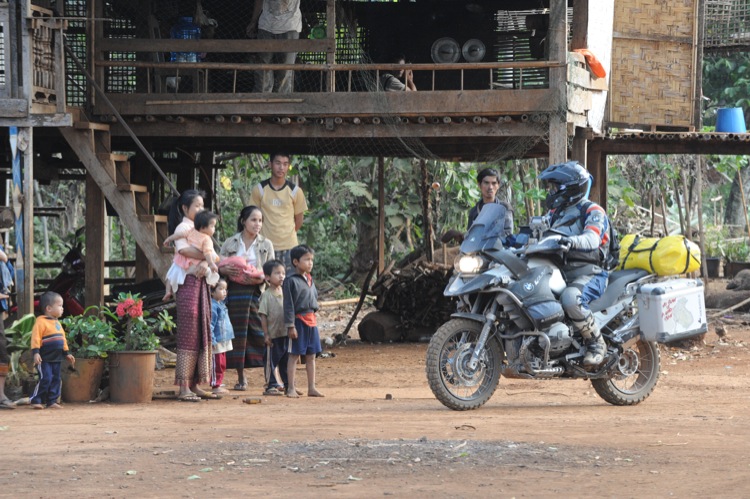Southeast Asia

Our plan is to not have a plan; to let things happen by chance. Herbert and I have spent a good part of our lives riding to the last corner of this big round rock: 40 years and 595,000 miles collectively - enough experience to rely upon. This time, we want to venture where we've never gone before. Our destination is Southeast Asia and our top priority is to have a good time.
Various maps, travel guides and picture books find their way into our hand luggage, but as far as our location, we will consult the people who know best - the local riders. Many things will not go according to plan - but this is precisely what makes traveling so exciting.
When we land in Bangkok, I recall a small, but very important detail concerning Thai traffic: people drive on the left. As soon as our bikes clear customs, they'll be unleashed into the tropical heat and hectic big city traffic. The mountains in the northwest of the country are beckoning with their endlessly winding roads. My brand new BMW F 800 GS, Desierto F has 0 miles on the clock, but not for long.
There's No Accounting for Taste
Peera, our contact who very quickly becomes a friend, is the Touratech importer for Thailand, with a shop in Bangkok. He picks us up from the airport, offers us coffee, and then helps to get our BMWs through customs. Peera is immensely proud to have us as his guests, and we're incredibly grateful for all he does, from assisting with route planning, to organizing a meeting with the BMW club, from acting as our chauffeur, and even riding with us. He advises us to eat at the night markets, as the locals do. As vegetarians, we're especially appreciative that Peera gives us a note written in Thai - something we hope will avoid our eating dogs or frog's limbs, ripped off for immediate consumption.
The night market in Ayutthaya is full of aromas, laughter and life. The many cook shops compete with one another for the guests' custom. The locals arrive with their whole family on a little moped, to be served dinner at one of the many tables set out in the open air. Steam rises out of giant rice bowls. Big flames emerge from the woks. Fresh juices are pressed, tasty, and healthy.

Monks and Temples
Buddhist temples with their high, golden chedis, or pagodas, stand like landmarks all over the country. About 94% of the Thai people practice Buddhism, based on the Theravada school that teaches a system of 26 stages. Simply put, each form of life aims to achieve the highest level, Nirvana - the never-ending ocean, peace of mind. This is the only way out of the eternal cycles of rebirth. Anyone who does good things will experience good things in return, and will be reborn at a higher level. Bad karma boomerangs and results in being reborn at a lower level.
Once in their lifetime, every Thai male spends one rainy season as a monk in a monastery concentrating on their inner values, away from the temptations of the world. Meditation sharpens the mind and opens the heart. After the period of abstinence, most men return to their old life to start a family.
Before entering one of the 25,000 wats, or monastic temples, we acquaint ourselves with the correct etiquette: remove motorcycle boots at the entrance, and under no circumstances should a woman ever touch a monk. Since we're wearing our riding gear, we don't need to worry about being "dressed too revealingly."
In the mountains of northern Thailand, we come across hundreds of orange robed pilgrims on a walking meditation. One after the other, they walk uphill in a long queue, barefoot and deliberate. We turn and position our motorcycles in a good spot on the side of the road to photograph them. But to Herbert's surprise, when he turns around with camera in hand, he finds himself looking directly into the small camera of a monk, wanting a lasting souvenir of the encounter with the two farangs (light-skinned foreigners) on their big bikes.

My First Time With Durian
In a hotel lift, a prohibition sign with a red prickly fruit crossed out arouses my curiosity. Through a quick conversation with the chatty receptionist, I learn that the sign pictures a durian. "It's extremely unwelcome on these premises," I am told, before he asks if I carry one with me. Satisfied that I don't, he continues to explain that due to their magnificent taste, it's considered the queen of fruits. I am, of course, reminded of Eve and the forbidden apple. Apparently, durian and alcohol do not mix, and there's been an occasional death after the two have been consumed together. Their smell is so penetrating, that if you break the no-durian rule in the hotel, you must pay an extra rental week. But this should in no way stop you from trying the regal fruit if the opportunity arises.
Several days later, we come across a heap of the prickly fruits on the side of the road. Next to it, packed in plastic bags, are portions ready for consumption. I approach cautiously, but I'm still caught off guard when I get a whiff of the white sticky pulp. I quickly stick it in my mouth before the smell makes me faint. The vendor shakes with laughter. Herbert vigorously objects when he sees that I want to put the rest of the uneaten durian into one of my panniers - and this time, I don't argue with him.
After a few miles my stomach gets hot. I have to burp constantly and I'm happy that I have a motocross helmet instead of a full-face helmet. For three days, all my pores ooze the stench of durian.